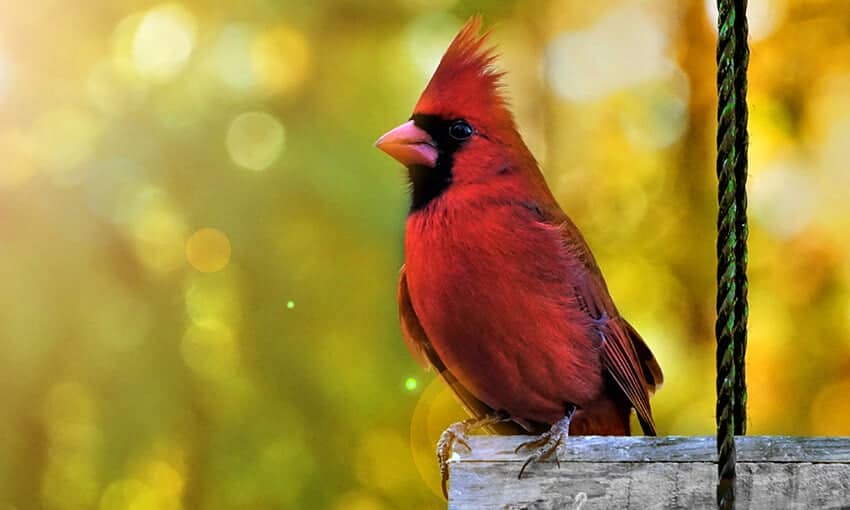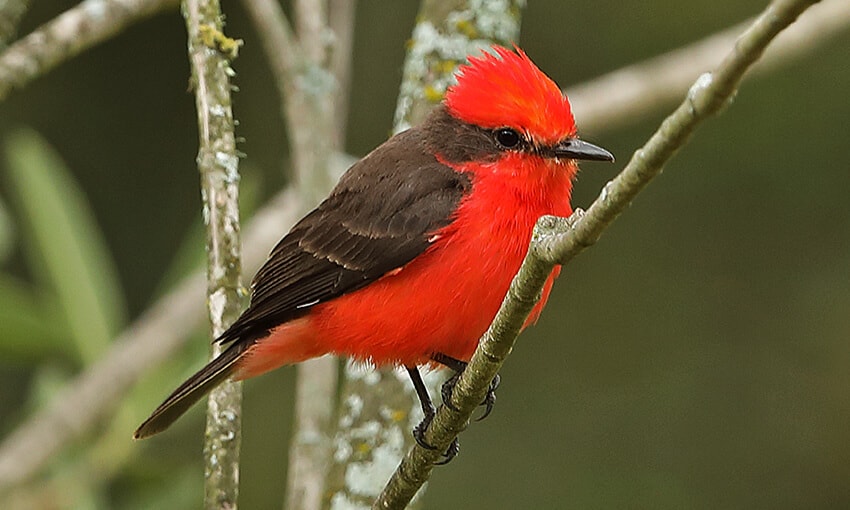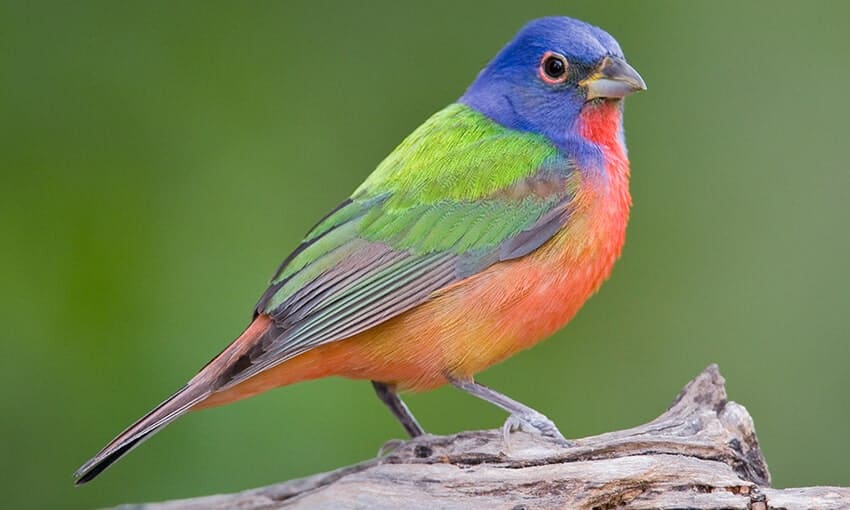The “red birds” of Texas include birds that are essentially red all over or have red coloration over more than half of their bodies. Four birds met these criteria, including the Summer Tanager, Cardinal, Vermilion Flycatcher, and the Painted Bunting (that just made the cut).
We at Wildbirdscoop are well aware of how blurry the lines can get with bird categories. Birds such as the red-headed woodpecker where the red—although prominent—covers well less than 50% of the body won’t be included.
Key Takeaways
- The ‘red birds’ of Texas refer to four species that are mostly red in color: the insect-catching Summer Tanager, the iconic Northern Cardinal, the luminous Vermilion Flycatcher, and the stunning Painted Bunting.
- Remarkable characteristics like the Summer Tanager’s adeptness at preying on wasps and the Northern Cardinal’s role as a state bird in seven U.S. states make these species quite cherished by birdwatchers.
- Despite the Summer Tanager population’s stability, the Painted Bunting’s numbers are dwindling due to habitat destruction, highlighting critical conservation issues.
Red Birds in Texas
Summer Tanager (Piranga rubra)

The Summer Tanager is about the same size as the Familiar Cardinal. Although called a “Tanager,” and previously classified as a “Tanager,” the Summer Tanager is now considered a member of the Cardinal family, (Cardinalidae).[1]
Its plumage and vocalizations are similar to other members of the Cardinal family. These birds are often out of sight, foraging high in trees, sometimes flying out to catch insects in flight.
Description:
Adult male Summer Tanagers are entirely bright red. Females and immature males are bright yellow-green—yellower on the head and underparts and slightly greener on the back and wings. The bill is pale yellow. Molting immature males can be patchy yellow and red.
- Length: 17 cm (6.7 in)
- Wingspan: – 28-30 (11-12 in.)
- Weight: 30 grams (1.1 oz.)
- Longevity: 4-7 years
The oldest Summer Tanager on record was a male who was at least 7 years, and 11 months old when he was recaptured and rereleased during banding operations in Texas in 1986.[3]
Range:
Summer Tanagers migrate annually from their range across the southern United States, south into central and northern South America.[4]
Voice:
The male’s song consists of melodic notes, repeated in a constant stream separated by short pauses. The song is similar to (but shorter than) the American Robin, typically lasting 2–4 seconds. [5]
It also has an agitated-sounding call pi-tuk or pik-i-tuk-i-tuk.[6]
Where to See:
These birds are often out of sight, foraging high in trees, sometimes flying out to catch insects in flight. They may frequent feeders stocked with a variety of seeds.
One of their favorite foods is the fruit of the Cymbopetalum mayanum tree found in Guatemala and Honduras. Planting this tree in yards may attract Summer Tanagers.
Conservation:
Summer Tanagers are not endangered. Overall, their population has remained steady through the 2014 North American Breeding Bird Survey.
Local populations have declined due to the loss of their preferred habitat – riverside forests were converted to agriculture and other uses.[7]
Additional Information:
The Summer Tanager is a bee and wasp specialist. It catches these insects in flight and kills them by beating them against a branch.
Before eating a bee, the Tanager rubs it on the branch to remove the stinger. Summer Tanagers eat larvae, too: first, they get rid of the adults, then they tear open the nest to get the grubs.[8]
Cardinal (Cardinalis cardinalis)

The Northern Cardinal (Cardinalis cardinalis) is a bird in the genus; it is also known colloquially as the Cardinalis
Description:
The northern cardinal is a mid-sized songbird. Males are slightly larger than the females.
The male is a brilliant red color with a black face mask over the eyes, extending to the upper chest. The female is mostly yellowish-tan with a slight reddish tint in the wings, the crest, and the tail feathers.[9]
The female also has a face mask, but it is less defined than the male’s. Both sexes have the prominent crest on their heads.
Young birds are similar in color to the female. Once prized as a pet, its sale as a caged bird was banned by the Migratory Bird Treaty Act of 1918.
- Length: – 21-23.5 cm (8.39.3 in)
- Wingspan: – 25-31 cm (9.8-12.2)
- Weight: – 33.6–65 g (1.19–2.29 oz)
- Longevity: – 10-15 years [10]
Adult Cardinals that survive their first one to two years have a life expectancy of up to 15 years. The oldest known Cardinal was a captive bird that lived 28.5 years.
Due to the high mortality rate of young birds, the average life span of a live hatchling is on the order of one year.
Range:
The Cardinal is a familiar bird throughout southeastern Canada and the eastern United States from Maine to Minnesota to Texas, and south through Mexico, Belize, and Guatemala. It is also an introduced species in a few locations such as Bermuda and Hawaii.
Its habitat includes woodlands, gardens, shrublands, and wetlands.
Where to See:
Cardinals are attracted to seed feeders in residential areas throughout their range. They are particularly fond of sunflower and safflower seeds.
In the wild, they are principally ground feeders, searching for weed seeds (about 90% of their diet) as well as insects.
Additional Information:
Pairs sometimes mate for several years, but some also ‘divorce’ between seasons or choose a new mate when one dies.
The Northern Cardinal is the state bird of seven U.S. states, more than any other species: Illinois, Indiana, Kentucky, North Carolina, Ohio, Virginia, and West Virginia. In each case, the particular state just refers to the bird as the “cardinal.”
Vermillion Flycatcher (Pyrocephalus obscurus)

The Vermilion Flycatcher is the most colorful Flycatcher in North America. The males are unmistakable with their brilliant red plumage
Description:
The Vermilion is a striking Flycatcher compared to others in its family. The males have bright red—vermillion crowns, chests, and underparts, with brownish wings and tails.
Their small, indistinct crest may become more apparent when the bird is agitated. Males also have a bright red head and underparts with a thick dark chocolate brown eye line that connects to the brown nape and back.
In bright light, males may appear almost glowing or fluorescent. Females lack the vivid red coloration but, have strong washes of color that make them stand out.[13]
- Length: 63 cm (6 in)
- Wingspan: 52 cm (9.5-10 in)
- Weight: 11-14 g (0.39 – 0.49 oz)
- Longevity: 4-5 years [14]
Range:
The Vermilion Flycatcher is found throughout South America and southern North America including the southwestern US from the southern tip of California through Arizona, throughout Texas, and into much of South America.
The Vermilion prefers wooded streams and lakes and semi-open environments.
Voice:
Ornithologist David Sibley describes the perching song as a pit pit pidddrrrreedrr, which is variable and important in establishing a territory.[15] The Cornell Lab of Ornithology [16] describes it as a ching-tink-a-le-tink, with an emphasis on the last syllable.
The following is another example of the Vermillion Flycatchers’ song [17] from xeno-canto.
Where to See:
Throughout its North American range, look for the Vermilion Flycatcher in open, shrubby habitats including scrubby deserts, lightly cultivated lands, riverine woodlands, and shrubby tropical lowlands.
Additional Information:
As aerial insectivores, they catch their prey while flying. Vermilion Flycatchers spend long periods sitting on exposed perches such as the tops of shrubs and fence lines. They watch for flying insects, catching them in midair by quick flights (sallies), and often returning to the same perch. [18]
Painted Bunting (Passerina ciris)

The Painted Bunting, a member of the Cardinal family, Cardinalidae, is native to North America. The male Painted Bunting is often described as the most beautiful bird in North America and as such has been nicknamed nonpareil, or “without equal.”[19]
Description:
As magnificent as it is, the Painted Bunting barely makes it into our collection of “red” birds. The red rump and underparts are distinctive, providing enough red to be admitted into this group.
The male of the species is, perhaps, one of the easiest birds to identify. The female and juvenile Painted Buntings are green and yellow-green — their colors and pattern provide camouflage from predators.
- Length: 12-14 cm (4.7-5.5 in)
- Wingspan: 21-23 cm (8.3 – 9.1 in)
- Weight: 11–14 g (0.39 – 0.49 oz)
- Longevity: 11 years [20]
Voice:
The Painted Bunting’s song is a series of short, musical phrases of thin, sweet, high-pitched notes lasting about 2 seconds. When establishing territorial boundaries in the spring, a male may sing 9–10 songs per minute from several perches within his territory.
Range:
The summer/breeding range of the Painted Bunting includes the south-central United States (Arkansas, Louisiana, Oklahoma, and Texas) as well as along the Atlantic coast from Georgia to northern Florida. They winter in South Florida, Cuba, the Bahamas, and Mexico, into Central America where they prefer the shrubby edges along the border of tropical forests or densely vegetated savanna. [21]
Where to See:
They can be seen at the Bird Blinds at Inks Lake State Park and Pedernales Falls State Park.
Painted Buntings are secretive birds and males are more commonly seen in the mornings when they sing from the tops of trees. Check out this video of two Painted Buntings to get a glimpse of their behaviors and incredible coloration.
Additional Information:
Painted Buntings often feed by hopping along the ground, cautiously stopping every few moments to look around. The Painted Bunting regularly eats a large quantity of grass seeds.
While breeding, Painted Bunting and nestlings mainly eat small invertebrates. When their breeding season has concluded, buntings migrate by night over short to medium distances.
The male Painted Bunting was once a popular caged bird, but its capture and holding is currently illegal. Populations are primarily declining due to habitat being lost to development, especially in coastal swamp thickets and woodland edges in the east.
They’re also declining in riparian habitats along winter migration routes through the United States and Mexico.
References
- [1] Summer Tanager: https://en.wikipedia.org/wiki/Summer_tanager#cite_note-2
- [2] The Cornel Lab: https://www.allaboutbirds.org/guide/Summer_Tanager/id
- [3] The Cornel Lab: https://www.allaboutbirds.org/guide/Summer_Tanager/overview
- [4] The Cornel Lab: https://www.allaboutbirds.org/guide/Summer_Tanager/maps-range
- [5] The Cornel Lab: https://www.allaboutbirds.org/guide/Summer_Tanager/sounds
- [6] Peterson, Roger Tory (2002): Field Guide to the Birds of Eastern and Central North America 5th ed.). Houghton Mifflin, Boston
- [7] The Cornel Lab: https://www.allaboutbirds.org/guide/Summer_Tanager/lifehistory
- [8] Bird Note.org: https://www.birdnote.org/show/summer-tanagers-wasp-hunters
- [9] Wikipedia: https://en.wikipedia.org/wiki/Northern_cardinal#cite_note-Wright-11
- [10] Wikipedia
- [11] Northern Cardinal – Birds of North America Online
- [12] Birds of the World, Cornell: https://birdsoftheworld.org/bow/species/norcar/cur/introduction#sex
- [13] Wikipedia: https://en.wikipedia.org/wiki/Vermilion_Flycatcher
- [14] The Spruce: https://www.thespruce.com/vermilion-flycatcher-profile-387292
- [15] Sibley, D. (2014)
- Alfred A. Knopf
- ISBN
- 978-0-307-95790-0
- OCLC
- 869807502
- [16] The Cornel Lab: https://www.allaboutbirds.org/guide/Vermilion_Flycatcher/sounds
- [17] xeno-canto: https://www.xeno-canto.org/299099
- [18] The Cornel Lab: https://www.allaboutbirds.org/guide/Vermilion_Flycatcher/id
- [19] https://en.wikipedia.org/wiki/Painted_bunting
- [20] World Health Rankings
- Stefanyk, D. (2001). “ [21]
- [21] Texas Government, State Parks https://tpwd.texas.gov/state-parks/inks-lake

